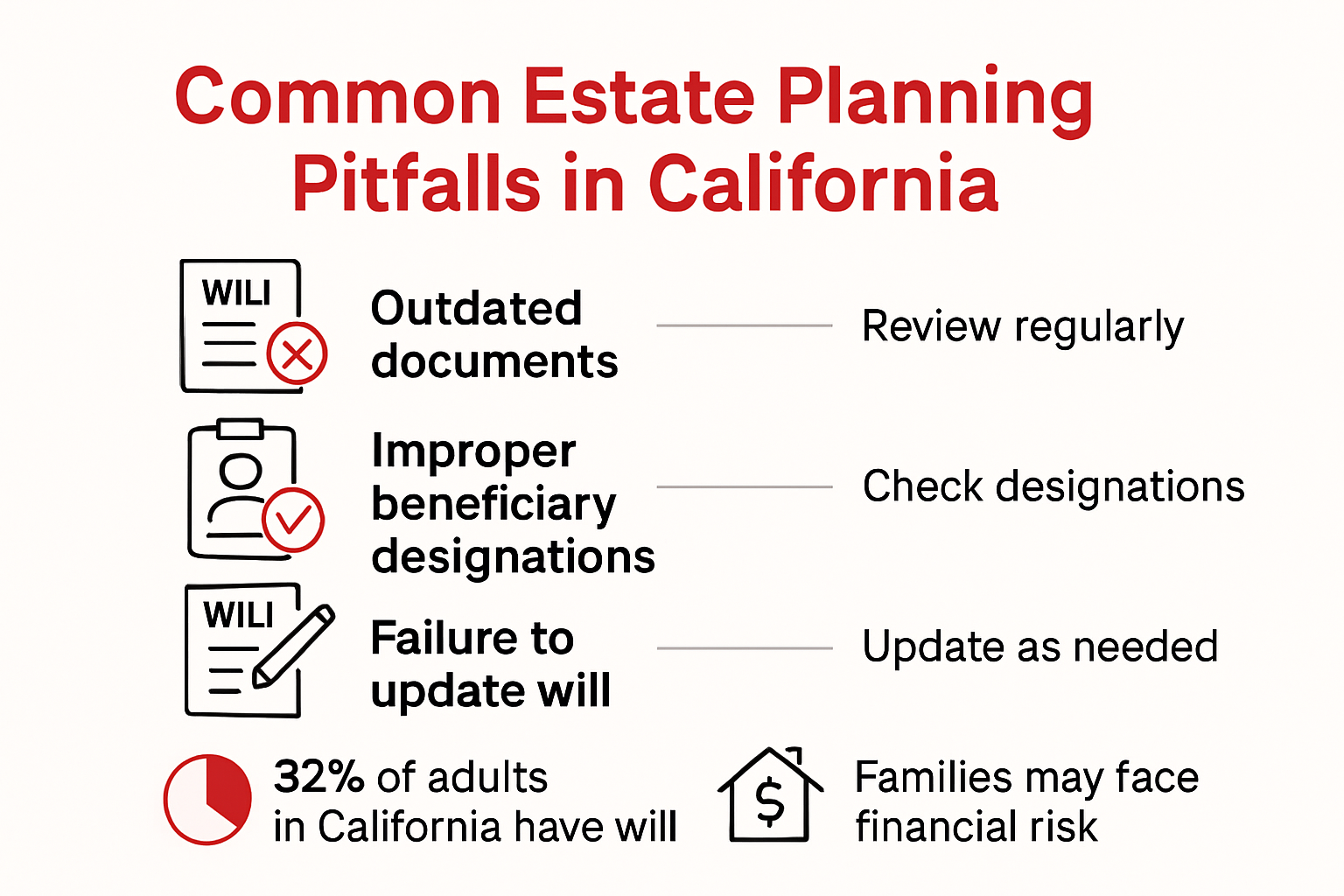
PARENTS & HOMEOWNERS: MY 7-STEP ESTATE PLANNING PROCESS WILL PROTECT YOUR HEIRS
From Creditors, Predators & Bad Choices, And Will Help You Become a (Bigger) Hero to Your Family!



California Estate Administration Checklist: Step-by-Step Guide
Estate administration in California might sound like a dry legal chore. Yet nearly 60 percent of Americans lack an up-to-date will or estate plan, and that can mean chaos for families left to pick up the pieces. Most people believe these legal steps are all about money and paperwork but in reality the true impact is about keeping families out of courtrooms and shielding loved ones from emotional and financial messes that no one expects.
Table of Contents
- Why Estate Administration Matters In California
- Essential Steps In The Estate Administration Checklist
- Protecting Children And Family Wealth
- Avoiding Common Estate Planning Pitfalls
Quick Summary
| Takeaway | Explanation |
|---|---|
| Estate administration is vital for family wealth. | Effective estate administration protects families’ assets and ensures smooth asset transfers according to the deceased’s wishes. |
| Obtain legal documents to initiate probate. | Securing essential documents like death certificates and wills is crucial for starting the probate process correctly. |
| Conduct thorough asset identification and valuation. | Accurate appraisals of estate assets ensure proper distribution and help determine tax liabilities for the estate. |
| Implement guardianship and financial protections for children. | Designating guardians and financial protections helps safeguard minors’ welfare and manage their inheritances responsibly. |
| Regularly update estate planning documents. | Keeping estate documents current prevents legal complications and aligns asset distribution with changing family circumstances. |
Why Estate Administration Matters in California
Estate administration represents far more than a legal formality in California. It is a critical process that protects families, preserves wealth, and ensures the systematic transfer of assets according to an individual’s final wishes. Understanding its importance can mean the difference between a smooth transition of wealth and potential family conflict or financial chaos.
Protecting Family Wealth and Legacy
In California, proper estate administration serves as a crucial safeguard for family financial stability. Learn more about California estate planning strategies that help families preserve their hard-earned assets. According to the California Department of Financial Protection and Innovation, estate planning is essential for individuals across economic spectrums, not just high-net-worth families. Without a comprehensive estate administration plan, assets may not automatically transfer to surviving spouses or children, potentially leaving loved ones vulnerable.
The legal complexities surrounding asset distribution can be overwhelming. When individuals fail to establish clear estate administration protocols, California state laws dictate how assets are divided. This default process might not align with the decedent’s true intentions, potentially creating unintended financial and emotional consequences for beneficiaries.
Legal Compliance and Dispute Prevention
Estate administration in California involves intricate legal procedures designed to ensure orderly asset transfer. The California Courts Self-Help Guide outlines that this process includes appointing a representative to manage the deceased’s assets, settle outstanding debts, pay necessary taxes, and distribute remaining resources to rightful heirs.
By following a structured estate administration approach, families can significantly reduce the likelihood of potential legal disputes. Clear documentation and transparent processes minimize misunderstandings among beneficiaries, providing a structured pathway for resolving potential conflicts. This systematic approach helps preserve family relationships during emotionally challenging times.
Financial and Emotional Risk Mitigation
Properly executed estate administration offers more than financial protection. It provides families with emotional security during challenging transitions. When individuals proactively plan their estate, they create a roadmap that guides their loved ones through complex legal and financial landscapes.
The California Attorney General’s Office emphasizes that dying without a comprehensive will or trust means assets will be distributed according to state law, which may not reflect personal wishes. By investing time in thorough estate administration planning, individuals can control asset distribution, make specific arrangements for minor children’s care, and provide clear guidance for their family’s financial future.
Effective estate administration is not about wealth accumulation but about responsible wealth transfer. It represents a final act of care and consideration for those we love most, ensuring our life’s work continues to support and protect our family even after we are gone.
Essential Steps in the Estate Administration Checklist
Navigating estate administration in California requires a systematic and thorough approach. Executors and administrators must carefully follow a comprehensive checklist to ensure legal compliance, protect beneficiary interests, and effectively manage the deceased’s estate. Learn more about probate procedures that can help streamline this complex process.
Obtaining Legal Documentation and Initiating Probate
The first critical step in estate administration involves securing essential legal documents. According to the Superior Court of California, County of Santa Clara, executors must prepare and file a comprehensive Petition for Probate. This formal legal document initiates the estate administration process and typically requires several key components:
- Death Certificate: Obtain multiple certified copies from the county recorder’s office
- Original Will: Locate and file the decedent’s most recent valid will
- Probate Petition: Complete detailed court documentation identifying the executor and estate assets
The petition serves as the foundational document that grants legal authority to manage and distribute the deceased’s estate according to their final wishes or state intestacy laws.
Asset Identification and Valuation
Accurate asset identification and valuation represent crucial steps in estate administration. The California State Controller’s Office highlights the important role of Probate Referees in appraising estate assets. Executors must conduct a comprehensive inventory that includes:
- Real estate properties
- Financial accounts
- Investment portfolios
- Personal property
- Business interests
- Retirement accounts
- Life insurance policies
Professional appraisals may be necessary for unique or high-value assets to ensure accurate valuation. This step is critical for determining estate tax liability and equitable distribution among beneficiaries.
Debt Settlement and Asset Distribution
The final phase of estate administration involves resolving outstanding financial obligations and distributing remaining assets. The UCLA School of Law recommends a methodical approach to this complex process. Executors must:
- Notify creditors about the estate
- Pay valid outstanding debts
- File final income tax returns
- Settle any estate or inheritance tax obligations
- Distribute remaining assets to beneficiaries according to the will or court determination
Estate administration demands meticulous attention to detail, legal knowledge, and emotional resilience. While the process can feel overwhelming, following a structured checklist helps executors navigate this challenging responsibility with confidence and precision. Professional legal guidance can provide invaluable support in managing these intricate legal and financial requirements.
Below is a process table summarizing the essential steps in California estate administration, as described in the article. This table provides a clear, sequential overview for readers responsible for managing an estate.
| Step | Key Actions/Considerations |
|---|---|
| Obtain Legal Documentation | Secure death certificates, locate and file original will, prepare probate petition |
| Initiate Probate | File Petition for Probate with court to gain authority as executor |
| Identify and Value Assets | Inventory real estate, financial accounts, investments, personal property, etc. |
| Appraise Assets | Use Probate Referees/professionals for unique or high-value assets |
| Notify Creditors | Inform creditors about the estate |
| Settle Debts and Taxes | Pay outstanding debts, file final income tax returns, settle estate taxes |
| Distribute Remaining Assets | Allocate assets to beneficiaries per will or court determination |

Protecting Children and Family Wealth
Protecting children and preserving family wealth represent critical objectives in comprehensive estate planning. California families face unique challenges in safeguarding their children’s financial future and maintaining generational wealth. Discover strategic asset protection approaches that can help secure your family’s financial legacy.
Establishing Guardianship and Financial Protections
Choosing the right guardian for minor children is one of the most consequential decisions in estate planning. According to the California Courts Self-Help Guide, guardians bear significant responsibilities to act in the child’s best interest and manage their finances prudently. Parents must carefully consider:
- Emotional Compatibility: Select guardians who share similar values and parenting philosophies
- Financial Stability: Ensure potential guardians have the economic resources to support the child
- Legal Documentation: Formally document guardian selections in comprehensive estate planning documents
The California Attorney General’s Office emphasizes that without proper legal instruments, asset distribution defaults to state law, potentially creating unintended consequences for children’s financial futures.
Creating Comprehensive Financial Protections
Beyond guardianship, California families must implement sophisticated financial protection strategies. The California Department of Financial Protection and Innovation recommends several critical components for protecting children’s inheritance:
- Establishing revocable living trusts
- Creating specific provisions for minor children’s financial management
- Implementing age-based distribution strategies
- Developing comprehensive financial powers of attorney
- Designing healthcare directives that protect children’s long-term interests
These strategies help ensure that children receive financial support aligned with their developmental needs while protecting assets from potential external risks.
Long-Term Wealth Preservation Strategies
Successful wealth preservation requires more than simple asset transfer. Families must develop nuanced strategies that educate and empower future generations. This approach involves creating structured financial education programs, implementing gradual wealth distribution mechanisms, and establishing clear guidelines for inheritance management.
Key considerations include:
- Creating educational trusts
- Developing financial literacy programs
- Implementing structured inheritance release mechanisms
- Protecting assets from potential future legal challenges
By taking a proactive and comprehensive approach to estate planning, California families can create robust protection mechanisms that safeguard both their children’s immediate needs and long-term financial well-being. Professional legal guidance becomes instrumental in navigating these complex strategies, ensuring that family wealth remains protected and purposeful across generations.
Avoiding Common Estate Planning Pitfalls
Estate planning represents a complex legal landscape where even minor oversights can lead to significant financial and emotional consequences for families. Discover critical strategies to prevent estate planning errors that could potentially derail your carefully constructed legacy.
Documentation and Update Challenges
One of the most prevalent estate planning pitfalls involves outdated or incomplete documentation. According to UC Davis Extension, failing to regularly review and update estate planning documents can create substantial legal complications. Critical documentation mistakes include:
- Incomplete Beneficiary Designations: Neglecting to specify precise beneficiary details
- Outdated Will Provisions: Not updating documents after major life changes such as marriage, divorce, or birth of children
- Missing Critical Clauses: Failing to include comprehensive provisions for potential scenarios
These documentation errors can lead to unintended asset distribution, potential family conflicts, and unnecessary legal challenges that could have been easily prevented through proactive planning.
The following table summarizes common estate planning pitfalls discussed in the article and the consequences they may cause for California families. It helps readers quickly identify and understand critical errors to avoid.
| Common Pitfall | Description | Potential Consequences |
|---|---|---|
| Outdated or Incomplete Documentation | Failing to update estate planning documents after life changes | Unintended asset distribution, family conflicts |
| Incomplete Beneficiary Designations | Not specifying or updating beneficiaries | Assets may go to unintended recipients |
| Naming Minors as Direct Beneficiaries | Listing children under 18 as direct beneficiaries | Legal delays, court-controlled assets |
| Lack of Financial & Legal Oversight | Neglecting asset protection, tax, or incapacity planning | Increased legal/tax risks, disputes |

Beneficiary Designation Complexities
Beneficiary designations represent a nuanced aspect of estate planning that demands meticulous attention. Common mistakes in this area can significantly impact asset transfer and inheritance. Potential pitfalls include:
- Naming minor children as direct beneficiaries
- Failing to update beneficiary forms after life transitions
- Not considering tax implications of beneficiary selections
- Overlooking contingent beneficiary designations
Professional legal guidance becomes crucial in navigating these complex selection processes, ensuring that beneficiary designations align with overall estate planning objectives and provide maximum protection for intended recipients.
Financial and Legal Oversight Risks
Estate planning extends beyond simple document preparation. Comprehensive planning requires anticipating potential financial and legal challenges that could compromise your family’s financial security. Key areas of potential oversight include:
- Inadequate asset protection strategies
- Insufficient tax planning mechanisms
- Lack of comprehensive incapacity planning
- Failure to consider potential family dynamics and potential disputes
By working with experienced legal professionals, families can develop robust estate plans that address potential risks proactively. This approach transforms estate planning from a reactive document preparation process into a strategic wealth preservation and family protection strategy.
Understanding and avoiding these common pitfalls requires continuous education, professional guidance, and a commitment to regular estate plan reviews. Each family’s financial landscape is unique, demanding personalized strategies that adapt to changing life circumstances while maintaining the core objective of protecting generational wealth and family harmony.
Frequently Asked Questions
What are the essential steps in the California estate administration process?
The essential steps include obtaining legal documentation, initiating probate, identifying and valuing assets, settling debts, and distributing remaining assets to beneficiaries.
How does estate administration in California protect family wealth?
Effective estate administration ensures that assets are transferred according to the deceased’s wishes, maintaining financial stability for the family and preventing potential disputes.
Why is it important to regularly update estate planning documents?
Regularly updating estate planning documents helps to align asset distribution with changing family circumstances and prevent legal complications stemming from outdated information.
What are some common mistakes to avoid in estate planning?
Common mistakes include having outdated or incomplete documentation, failing to update beneficiary designations, naming minors directly as beneficiaries, and neglecting financial or legal oversight strategies.
Take Control of Estate Administration in California—Start with Trusted Guidance
Navigating the estate administration checklist in California can feel overwhelming, especially when legal documents, probate filings, and family protection are on the line. Many families worry about probate delays, rising costs, or accidental mistakes that could disrupt their legacy. At the Estate Planning – Law Office of Eric Ridley, we address these exact challenges so you do not have to face them alone. Our firm specializes in clear step-by-step support for estate planning, probate administration, trust creation, and will drafting, ensuring your hard work benefits the people you love most.

If you want to protect family wealth, avoid unnecessary legal disputes, and achieve real peace of mind, now is the time to act. Begin your next steps with a dedicated advisor who values your legacy. Contact us today at https://ridleylawoffices.com and discover how we can help you secure your family’s future.
Recommended
- California Probate Process Explained: 2025 Guide for Families and Homeowners – Law Office of Eric Ridley
- Preparing for Probate Court in California: Essential Steps for 2025 – Law Office of Eric Ridley
- California Small Estate Affidavit: Essential Guide for 2025 – Law Office of Eric Ridley
- The Impact of California Laws on Estate Planning – Law Office of Eric Ridley
